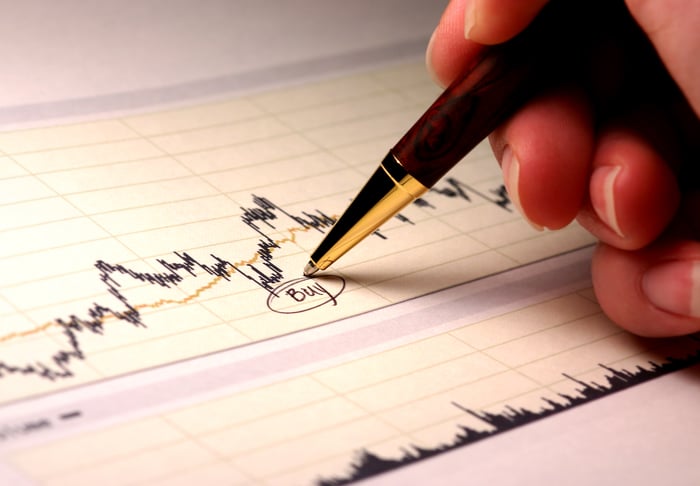To some, investing in the stock market can be incredibly tricky. If we look back at the broad-based S&P 500 (^GSPC 0.02%) since this century began, the index has encountered two major corrections of roughly 50% during the dot-com bubble, and 57% during the Great Recession.
The magnitude of these bear market moves is a big reason Gallup recently reported that the number of investors in U.S. stocks has tied an all-time low. Just 52%, or roughly one out of every two adults, owns stock. The worrisome aspect of this data is that the stock market has shown, time and again, that it's the greatest wealth creator of all asset classes. Be it gold, oil, bonds, or housing, the 7% annual return in stocks, inclusive of dividend reinvestment, tops them all. The 48% of adults who don't own stocks runs the risk of having an insufficient nest egg come retirement, or, worse yet, being trampled by the national inflation rate and losing purchasing power with what they do have put away for retirement.

Image source: Getty Images.
So, what's a person to do? The ideal answer is to invest in the stock market, but understandably there's a major lack of trust among baby boomers and millennials following the massive plunge in valuations between 2007 and 2009. Investing involves the risk of losing money, plain and simple. There is no such thing as a surefire investment.
But what if I told you there was an investment that was as close to surefire (without being guaranteed) as you can get?
The closest you'll get to a surefire investment opportunity
Yardeni Research, a sell-side consulting firm founded by namesake President and Chief Investment Strategist Ed Yardeni, has painstakingly documented the correction history of the broad-based S&P 500 over multiple decades. Since the S&P 500 is weighted by market cap and not point value like the Dow Jones Industrial Average, it's a far better measure of U.S. economic and stock market health.
Since Jan. 1, 1950, the S&P 500 has undergone 35 corrections whereby its aggregate point value has fallen by at least 10%, when rounded to the nearest whole number. In context, we're talking about an average correction in stocks occurring about once every two years. That's probably a lot more common than you realized.

Image source: Getty Images.
However -- and here's the really key point -- all 35 of these stock market corrections have been completely erased within a matter of weeks and months, and in rarer cases years, by a bull market rally. I repeat, in 35 out of 35 instances since 1950, the S&P 500 has erased any stock market corrections totaling 10% or higher at some point in the future. That's a 100% success rate over nearly three dozen data points. Buying any major dip in the S&P 500 is about as close to a guarantee as you're going to get when it comes to investing in the stock market.
What's more, the S&P 500 spends a considerably longer amount of time expanding and moving higher than it does in correction mode. If we were to add up the aggregate number of days the S&P 500 has spent in correction since Jan. 1, 1950, the number of bull market days is about three times as much.
So what's this nearly surefire investment? While not exactly the most exciting equity, the SPDR S&P 500 ETF (SPY -0.05%) will fairly closely mirror the performance of the S&P 500. Investors will enjoy a 1.9% yield as well, which more than covers the nominal 0.09% net expense ratio associated with this ETF. The data pretty clearly shows that if you were to buy the SPDR S&P 500 ETF and hang on for a long time, you should make nominal and real money gains.

Image source: Getty Images.
Buying and holding is truly the most effective strategy
You might be wondering why you can't just dive out of the SPDR S&P 500 ETF at the first hints of stock market trouble and then jump right back in after an official correction of 10% has been reached. The answer is pretty simple: Timing the market with any long-term accuracy isn't possible.
According to a study by J.P. Morgan Asset Management, buying and holding the S&P 500 between Jan. 1, 1995, and Dec. 31, 2014, would have netted an investor a 555% return, which works out to almost 10% per year. Mind you, this stunning gain occurred despite holding through both the dot-com bubble bursting and the Great Recession. Comparatively, missing just the 10 best days out of this more than 5,000-day trading period would have more than halved your 555% gain. If you missed a little more than 30 of the best trading days, your gains would have completely disappeared.
But here's where things get really interesting. Six out of 10 of the top-performing days in the S&P 500 over this 20-year period came within two weeks of its 10 worst-performing days. Unless you have a time machine handy, the chances of correctly guessing when to dive in and out are virtually zero. J.P. Morgan Asset Management's data, and Yardeni Research's data, clearly shows the value in buying and holding your investments over a long period of time.

Image source: Getty Images.
An easy way to further increase your chances of success
Again, while there is no such thing as a "guarantee" when it comes to investing, there is another way you can increase your odds of success.
In addition to considering the SPDR S&P 500 ETF as an investment option, and holding your investment over a long period of time, you should also strongly consider adding to your holdings at regular intervals. Regularly buying stock, regardless of where the stock market is valued, should give you a favorable cost basis over the long run. This should protect you if you happened to buy stock near a temporary peak in the market.
If you're buying stock at regular intervals, the data from Yardeni Research suggests you should make nominal and real money gains over the long term.





